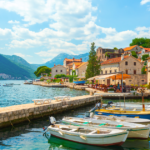Last Updated on June 13, 2024 by Rikki
Looking to explore traditional European spirits? Look no further! From Swiss Absinthe to Dutch Genever and Austrian Schnaps, Europe has a wide range of iconic alcoholic beverages to offer.
While France is famous for its vineyards and Portugal for its port wine, there are plenty of other spirits to discover across the continent.
Whether you’re up for tasting rum in Gran Canaria, cycling along the Absinthe Trail in Switzerland, trying Dutch Genever in Amsterdam, sipping on Cognac in France, or learning about Hungarian herbal liqueur in Budapest, there are endless opportunities to expand your palate and indulge in the rich history and flavors of traditional European spirits.
If you have a passion for hiking, you might also find the following trail in the Azerbaijani mountains intriguing: Fairy Villages and Trails – Five Best Routes in the Mountains of Azerbaijan.
Swiss Absinthe
Swiss Absinthe is a highly popular and iconic spirit with a rich history. Known for its vibrant green color and herbal flavor profile, Swiss Absinthe has captivated drinkers for centuries.
The History of Swiss Absinthe
The history of Swiss Absinthe dates back to the late 18th century when it was first created as a medicinal elixir. It quickly gained popularity as a recreational drink and became the beverage of choice for many artists, writers, and bohemians during the Belle Époque period. However, due to concerns over the high alcohol content and the presence of thujone, a compound found in wormwood, Swiss Absinthe was banned in Switzerland and many other countries in the early 20th century. It wasn’t until the late 20th century that the ban was lifted and Swiss Absinthe experienced a resurgence in popularity.
The Production Process of Swiss Absinthe
The production process of Swiss Absinthe is a labor-intensive and precise craft that requires great attention to detail. It starts with a selection of high-quality botanical ingredients, including grande wormwood, anise, and fennel. These ingredients are carefully measured and macerated in alcohol to extract their essential oils and flavors. The resulting mixture, known as the macerate, is then distilled in a traditional copper still to separate the alcohol from the botanicals. Finally, the distilled absinthe is diluted to the desired proof, typically around 68% ABV, and bottled. The entire process can take several weeks or even months to complete.
Popular Swiss Absinthe Brands
Swiss Absinthe is produced by several renowned distilleries, each with its own unique style and flavor profile. Some of the most popular Swiss Absinthe brands include:
- La Clandestine: La Clandestine is often regarded as one of the finest Swiss Absinthes. It is made using traditional methods and features a delicate balance of herbal and anise flavors.
- Kübler: Kübler is another well-known Swiss Absinthe brand with a rich history. It has a slightly stronger anise flavor and a smooth, velvety texture.
- Duplais: Duplais absinthes are known for their complex and well-rounded profiles. They often have a pronounced wormwood flavor and a hint of bitterness.
These brands, along with many others, offer a wide range of Swiss Absinthes to cater to different preferences and tastes.
Dutch Genever
Dutch Genever, also known as jenever, is a traditional Dutch spirit with a long and fascinating history. It is considered the predecessor to modern-day gin and is known for its unique flavor profile and production process. There are several different types of Dutch Genever, each with its own distinct characteristics. Some of the most famous Dutch Genever distilleries include Bols, Rutte, and Zuidam.
A Brief Overview of Dutch Genever
Dutch Genever has been produced in the Netherlands since the 17th century and is one of the country’s oldest spirits. It is made by distilling a mash of malted grains, primarily malted barley, and blending it with a juniper-infused spirit. The result is a spirit that is malty and full-bodied, with a pronounced juniper flavor. Dutch Genever is often enjoyed neat or in cocktails like the classic Genever Martini.
The Different Types of Dutch Genever
There are three main categories of Dutch Genever, each with its own production methods and flavor profiles:
- Jonge Genever: Jonge Genever is the most common type of Dutch Genever and is made from a blend of malt wine and neutral spirits. It has a relatively low malt wine content and a smooth, light-bodied profile with subtle juniper flavors.
- Oude Genever: Oude Genever is a more traditional style of Dutch Genever that is made primarily from malt wine. It has a higher malt wine content and a fuller, more robust flavor profile. Oude Genever often exhibits more pronounced malt and juniper flavors.
- Korenwijn: Korenwijn is the oldest and most traditional style of Dutch Genever. It is made almost entirely from malt wine and is aged in oak casks, which gives it a rich and complex flavor profile. Korenwijn is often enjoyed as a sipping spirit and is known for its smoothness and depth of flavor.
Famous Dutch Genever Distilleries
Several distilleries in the Netherlands are renowned for their production of Dutch Genever. Some of the most famous Dutch Genever distilleries include:
- Bols: Bols is one of the oldest distilleries in the Netherlands, with a history dating back to 1575. They produce a wide range of spirits, including a variety of Genevers with different flavor profiles.
- Rutte: Rutte is a family-owned distillery that has been producing spirits since 1872. They are known for their traditional production methods and use of high-quality ingredients.
- Zuidam: Zuidam is a relatively young distillery that was founded in 1975. They are known for their artisanal approach to spirit production and their commitment to quality.
These distilleries, along with many others, offer a wide selection of Dutch Genevers, each with its own unique characteristics.
Austrian Schnaps
Austrian Schnaps is a traditional Austrian spirit that is highly regarded for its craftsmanship and quality. Schnaps, which is similar to fruit brandy, is made by fermenting and distilling various fruits, such as apricots, pears, and plums. The distillation process involves careful temperature control and skillful blending to capture the flavors of the fruits. Austrian Schnaps is known for its pure and intense fruit flavors, making it a favorite among enthusiasts and connoisseurs.
What is Austrian Schnaps?
Austrian Schnaps is a type of fruit brandy that is made using a traditional method called the “double distillation” process. This process involves fermenting and distilling the fruit mash twice to achieve a clear and concentrated spirit. The first distillation separates the alcohol from the fruit solids, while the second distillation refines the spirit and removes any impurities. Austrian Schnaps is typically bottled at a high proof, ranging from 40% to 60% ABV, to preserve the intense fruit flavors.
The Distillation Process of Austrian Schnaps
The distillation process of Austrian Schnaps requires great skill and attention to detail. It starts with the careful selection and preparation of the fruit. The fruit is then mashed and fermented to convert the sugars into alcohol. Once fermentation is complete, the mash is distilled twice in a traditional copper still. The first distillation, known as the “Vorlauf,” separates the alcohol from the fruit solids and impurities. The spirit is then collected and subjected to a second distillation, known as the “Nachlauf,” to further refine and concentrate the flavors. The resulting spirit is then aged in glass or stainless steel containers to allow the flavors to mellow and develop.
Notable Austrian Schnapps Varieties
Austrian Schnapps comes in a wide variety of flavors, each showcasing the unique characteristics of the fruit used. Some of the most notable Austrian Schnapps varieties include:
- Marillenschnaps: Marillenschnaps, also known as apricot schnapps, is one of the most popular and widely produced Austrian Schnaps. It is made by distilling ripe apricots and has a sweet, fruity flavor with subtle hints of almond.
- Williams Birne: Williams Birne, or Williams pear schnapps, is made from the juice of ripe Williams pears. It has a delicate, floral aroma and a smooth, velvety texture. Williams Birne is often enjoyed as a digestif.
- Vogelbeerschnaps: Vogelbeerschnaps, or rowanberry schnapps, is made from the berries of the rowan tree. It has a tart, slightly bitter flavor with hints of citrus and spice. Vogelbeerschnaps is often enjoyed as a shot or used in cocktails.
These are just a few examples of the many varieties of Austrian Schnaps available. Each variety offers a unique taste experience, reflecting the flavors of the fruits used.
Other Traditional European Spirits to Try
In addition to Swiss Absinthe, Dutch Genever, and Austrian Schnaps, there are several other traditional European spirits worth trying. These spirits showcase the rich diversity and craftsmanship of European distillation traditions. Some popular examples include:
Czech Becherovka
Czech Becherovka is a herbal liqueur that is made from a secret blend of herbs and spices. It has a distinctive bitter-sweet taste and is often enjoyed as a digestif or used in cocktails like the traditional Becherovka and tonic.
Polish Żubrówka
Polish Żubrówka is a unique vodka that is flavored with bison grass, giving it a distinctive herbal aroma and flavor. It is often enjoyed neat or in cocktails like the classic Żubrówka and apple juice.
French Chartreuse
French Chartreuse is a herbal liqueur that is made by Carthusian monks following a secret recipe. It has a complex and aromatic flavor profile, with hints of citrus, herbs, and spice. Chartreuse is often enjoyed as a digestif or used in cocktails like the classic Last Word.
Italian Limoncello
Italian Limoncello is a lemon liqueur that is made from the zest of lemons, alcohol, sugar, and water. It has a bright and refreshing flavor and is often enjoyed chilled as a digestif or used in cocktails like the popular Limoncello Martini.
Greek Ouzo
Greek Ouzo is an anise-flavored liqueur that is often enjoyed as an aperitif or a digestif in Greece. It has a distinct licorice-like flavor and is usually served ice-cold with water, which turns it milky white.
These traditional European spirits offer a wide range of flavors and experiences, each representing the unique heritage and craftsmanship of its respective country.
Where to Try Traditional European Spirits
For those interested in trying traditional European spirits, there are several recommended bars and distilleries to visit in different European countries.
Recommended Bars and Distilleries in Switzerland
When it comes to Swiss Absinthe, some recommended bars and distilleries in Switzerland include:
- Maison de l’Absinthe in Môtiers: This museum and distillery offer a unique opportunity to explore the history and production process of Swiss Absinthe. Visitors can also sample a variety of absinthes and learn about the traditional serving techniques.
- Bar du Nord in Zurich: This stylish bar offers a wide selection of Swiss Absinthes, including some rare and limited-edition bottles. The knowledgeable staff can provide guidance and recommendations based on individual preferences.
Top Genever Tasting Rooms in the Netherlands
For those interested in Dutch Genever, some top Genever tasting rooms in the Netherlands are:
- House of Bols in Amsterdam: This interactive museum and tasting experience offer visitors the chance to learn about the history and production process of Dutch Genever. Tastings are available, allowing visitors to sample different Genever styles and flavors.
- hopjes, and jenevers. Their tasting room provides a unique opportunity to sample a wide variety of Genevers and explore the different flavor profiles.
Austrian Schnaps-Producing Regions to Visit
To explore Austrian Schnaps production, some recommended regions to visit in Austria include:
- Tyrol: Tyrol is known for its picturesque landscapes and traditional schnaps production. The region is home to several distilleries that offer tours and tastings, allowing visitors to learn about the distillation process and sample a variety of schnaps varieties.
- Salzburg: Salzburg is another region with a rich schnaps-producing heritage. Distilleries in Salzburg often use local fruits, such as apples and pears, to create unique and flavorful schnaps. Visiting these distilleries provides a chance to taste schnapps made from locally sourced ingredients.
Famous Places to Experience European Spirits in Other Countries
For those interested in experiencing traditional European spirits in countries beyond Switzerland, the Netherlands, and Austria, there are many famous places to visit, including:
- France – Cognac: Cognac, located in the Charente region of France, is the birthplace of the world-renowned Cognac. Visitors can explore the vineyards, distilleries, and cellars to learn about the production process and sample a variety of Cognacs.
- Italy – Amalfi Coast: The Amalfi Coast in Italy is famous for its production of Limoncello. Here, visitors can visit local distilleries and taste authentic, locally-made Limoncello.
- Greece – Lesvos: Lesvos, an island in Greece, is the birthplace of Ouzo. Visitors can explore the charming villages and tavernas to sample the local Ouzo, often accompanied by traditional Greek meze.
These famous places offer unique opportunities to immerse oneself in the heritage and culture of these traditional European spirits.
How to Enjoy Traditional European Spirits
To truly appreciate traditional European spirits, it is important to know the best ways to drink and serve them. Each spirit has its own unique characteristics that can be enhanced by specific serving techniques and pairings.
Best Ways to Drink Swiss Absinthe
Swiss Absinthe is traditionally enjoyed by pouring a small amount of the spirit into a glass and placing a slotted spoon on top. A sugar cube is then placed on the spoon, and cold water is slowly dripped over the sugar cube, causing it to dissolve into the absinthe. This method, known as the traditional French absinthe ritual, allows the flavors and aromas of Swiss Absinthe to develop and mellow. The resulting drink is typically diluted to a ratio of three to five parts water to one part absinthe.
Traditional Serving Techniques for Dutch Genever
Dutch Genever is often enjoyed neat or on the rocks, allowing the flavors of the spirit to shine through. However, it can also be used in various cocktails, such as the classic Genever Martini or the Dutch Negroni. When serving Dutch Genever in cocktails, it is important to use high-quality ingredients and balance the flavors to complement the malt and juniper flavors of the spirit.
Austrian Schnaps Pairings and Cocktail Ideas
Austrian Schnaps is typically enjoyed as a sipping spirit or as a digestif after a meal. It pairs well with a variety of desserts, including fruit tarts, cakes, and chocolates. Some popular cocktails that feature Austrian Schnaps include the Apricot Sour, which combines apricot schnapps, lemon juice, and simple syrup, and the Pear Martini, which combines pear schnapps, vodka, and a hint of lemon.
Tips for Tasting Other European Spirits
When tasting other European spirits, it is important to approach each spirit with an open mind and a willingness to explore new flavors and aromas. Take the time to appreciate the unique characteristics of each spirit and consider how they evolve on the palate. It can be helpful to taste spirits in a controlled environment, such as a tasting room or a quiet bar, where the focus is solely on the drink.
The Cultural Significance of Traditional European Spirits
Traditional European spirits, such as Swiss Absinthe, Dutch Genever, and Austrian Schnaps, hold a significant place in the cultural heritage of their respective countries. These spirits have inspired artists, writers, and musicians for centuries and have become emblematic of the countries from which they originate.
Historical and Artistic References to Swiss Absinthe
Swiss Absinthe has played a prominent role in art and literature, particularly during the Belle Époque period. It has been referenced in famous works such as “The Absinthe Drinker” by Édouard Manet and “L’absinthe” by Edgar Degas. Swiss Absinthe has also been associated with creative movements like Impressionism and Symbolism, contributing to its cultural significance.
Dutch Genever in Literature and Popular Culture
Dutch Genever has been referenced in various works of literature and has played a role in Dutch cultural traditions. It is often associated with the Dutch Golden Age and is depicted in paintings by Dutch Masters such as Johannes Vermeer. In popular culture, Dutch Genever has been featured in films and television shows set in the Netherlands, further cementing its cultural significance.
Traditional Uses of Austrian Schnaps in Austrian Cuisine
Austrian Schnaps is deeply ingrained in Austrian culture and cuisine. It is often enjoyed as a digestif after a hearty meal and is considered an essential part of the Austrian dining experience. Austrian Schnaps is also used in cooking and baking, adding a rich and aromatic flavor to dishes such as fruit compotes, sauces, and desserts.
European Traditions and Festivals Celebrating Spirits
Throughout Europe, there are numerous traditions and festivals that celebrate traditional spirits. These events often include tastings, competitions, and cultural performances. Some examples include the Fête de l’Absinthe in Switzerland, the Dutch Jenever Festival in the Netherlands, and the Schnapps Festival in Austria. These celebrations highlight the cultural significance and importance of these traditional European spirits.
Finding Traditional European Spirits Outside of Europe
For those who want to enjoy traditional European spirits outside of Europe, there are several options available.
Importing Traditional European Spirits
Traditional European spirits can often be imported into other countries, allowing consumers to enjoy these iconic beverages. It may be necessary to check local regulations and importation laws to ensure compliance with any restrictions or taxes.
Specialty Liquor Stores and Online Retailers
Specialty liquor stores and online retailers often carry a wide selection of traditional European spirits. These establishments can provide access to a range of brands and varieties that may not be available in regular liquor stores.
Experiencing European Spirits at International Bars and Restaurants
International bars and restaurants that specialize in European cuisine often feature a selection of traditional European spirits on their menus. This provides an opportunity to experience these spirits in an authentic setting, complemented by the flavors and dishes of their respective countries.
Traditional European Spirit Tours and Events
For those seeking a more immersive experience with traditional European spirits, there are various tours and events available.
Popular Spirit Festivals and Events in Europe
Europe is home to many spirit festivals and events that celebrate traditional European spirits. These events often feature tastings, workshops, and cultural performances. Some popular spirit festivals and events in Europe include the Absinthe Festival in France, the Gin Festival in the Netherlands, and the Schnaps Route in Austria.
Guided Tours of European Distilleries and Tasting Sessions
Guided tours of European distilleries offer a unique opportunity to learn about the production process of traditional European spirits and sample different varieties. Many distilleries offer guided tours that provide insights into the history, craftsmanship, and traditions behind these spirits.
Exploring the Craft Cocktail Scene in Europe
Europe has a vibrant craft cocktail scene, with many talented bartenders and mixologists who incorporate traditional European spirits into their creations. Exploring the craft cocktail scene can offer new and innovative ways to enjoy these traditional spirits.
European Bartenders and Mixologists
European bartenders and mixologists are renowned for their creativity and expertise when it comes to crafting cocktails. Many have won prestigious awards and accolades for their innovative creations. Exploring the craft cocktail scene in Europe provides an opportunity to experience the unique flavors and techniques employed by these talented professionals.
Innovative Cocktail Recipes Featuring Traditional European Spirits
Craft cocktail bars throughout Europe offer a wide selection of innovative cocktail recipes featuring traditional European spirits. These cocktails often combine classic techniques with modern twists, resulting in unique flavor combinations. Whether it’s a Swiss Absinthe-based cocktail, a Dutch Genever Martini, or an Austrian Schnaps-inspired creation, there are countless inventive and flavorful options to explore.
Trends in European Mixology
European mixology is constantly evolving, with new trends and techniques emerging regularly. From the revival of classic cocktails to the use of molecular mixology techniques, European mixologists are at the forefront of innovation in the cocktail world. Exploring these trends provides insight into the current state of mixology in Europe and showcases the versatility of traditional European spirits.
In conclusion, traditional European spirits such as Swiss Absinthe, Dutch Genever, and Austrian Schnaps have a rich history and cultural significance. They offer a unique and diverse range of flavors and experiences for those willing to explore their heritage and craftsmanship. Whether enjoyed in their countries of origin or experienced abroad, traditional European spirits provide a glimpse into the traditions, flavors, and artistry of the European spirits industry.


















